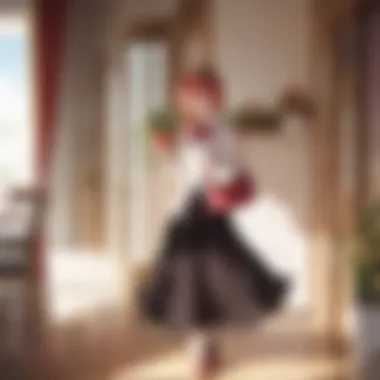A Detailed Exploration of Fruit Basket Anime Season 2


Intro
In recent years, Fruit Basket has re-emerged as a significant player in the anime landscape, captivating both old fans and new audiences alike. Season 2 of this series continues to build on the foundations laid in its initial season, expanding its themes and deepening character arcs. This analysis seeks to unpack these developments, highlighting how they enhance the overall narrative.
Character Profiles
Overview of Main Characters
The character development in Fruit Basket Season 2 is pivotal. Tohru Honda serves as the emotional core of the series. Her kindness and resilience shine through as she navigates complex relationships with the members of the Sohma family. Kyo Sohma’s growth is particularly noteworthy. He grapples with his identity and seeks acceptance. His interactions with Tohru reveal a vulnerability that enriches his character.
Yuki Sohma, often portrayed as the calm one, faces his own struggles with self-worth and the burden of being the "Prince" of the school. The interplay between these three main characters captures the essence of personal growth amid adversity. Each episode provides insights into their pasts, showing how their experiences shape their actions in the present.
Supporting Characters
Supporting characters add layers to the story. Shigure Sohma, the enigmatic figure, balances humor with deeper wisdom, serving as a mentor-like presence. Akito Sohma, introduced more thoroughly in this season, represents the darker side of the Sohma family dynamics, revealing the pain and pressure that come from the family curse. The development of supporting characters like Hatori and Kagura adds richness to the overall tapestry of relationships within the show.
Theme Exploration
Central Themes
The central themes of Fruit Basket Season 2 delve into acceptance, love, and the complexities of human emotions. The series explores how trauma can shape individuals and relationships. Tohru's unwavering optimism serves as a counterpoint to the struggles faced by her friends, illustrating the power of emotional support and understanding.
Cultural References
Cultural references in Fruit Basket deepen its narrative. The concept of family dynamics and obligations resonates strongly within Japanese culture. The show addresses the societal expectations of success, love, and duty, which are relatable themes in many cultures. This intersection makes Fruit Basket a poignant reflection on the nature of family and friendship.
"The emotional weight carried by the characters is what makes Fruit Basket resonate with its audience, touching on universal themes of love and belonging."
Popular Series and Recommendations
While Fruit Basket stands out, other anime series deserve attention this season. Here are a few notable mentions:
- Attack on Titan – A gripping tale of survival and freedom.
- My Hero Academia – A modern take on superheroes and moral dilemmas.
- Dorohedoro – A blend of mystery, action, and dark humor that captivates viewers.
Hidden Gems in Manga
For manga readers, exploring lesser-known titles can be rewarding. Consider titles like Kakushigoto, a touching story about a father’s love and the lengths he goes to protect his daughter from his profession.
Prelude to Fruit Basket
The introduction of Fruit Basket is crucial in establishing the context for the series, particularly as it sets up essential understandings of its characters and themes. This anime, originally based on a manga series by Natsuki Takaya, has become significant due to its exploration of complex emotional narratives and deep character interactions. Understanding the roots of Fruit Basket allows viewers to appreciate the nuances introduced in season two.
Overview of the Series
Fruit Basket centers on Tohru Honda, a kind-hearted high school girl who finds herself living with the Sohma family, a clan cursed to transform into animals from the Chinese zodiac when hugged by someone of the opposite sex. The narrative combines elements of romance, comedy, and drama, leading to significant character growth and interpersonal dynamics. It addresses profound themes like love, acceptance, and the scars of past traumas while gradually unveiling the backstories of its characters.
This series stands out for its character-driven story arcs and emotional depth. In season two, viewers witness a more evolved interaction among characters, further layering their personal struggles and relational developments.
Origin and Release History
Fruit Basket first graced our screens in the early 2000s, but it was the 2019 adaptation that breathed new life into the franchise. This modern rendition aims to stay faithful to the manga's storyline, which connects with a diverse audience, both old and new. The release strategy involved meticulously spaced episodes that allowed fans to digest the complex narratives slowly.
The series has been positively received, generating discussions online, especially on platforms like Reddit, where fans share insights and analyses. The blend of nostalgia with updated animation techniques has made it relevant in contemporary culture, thereby impacting the international anime community.
"The new adaptation not only reintroduces the beloved story but also deepens the emotional layers that resonate with viewers today."


Overall, establishing the importance of Fruit Basket as a cultural artifact enhances the audience's understanding of its ongoing relevance in anime discussions and its thematic implications that expand beyond mere entertainment.
Fruit Basket Season 2: An Overview
The second season of Fruit Basket is pivotal in the overall narrative. It dives deeper into the intricacies of familial relationships and personal struggles that define the characters. Understanding this season is crucial, as it enhances the viewer’s comprehension of the first season's groundwork. This installment not only advances the central storyline but also enriches the character development significantly. It showcases emotional growth and conflict, setting the stage for upcoming developments in the series.
Plot Summary and Key Developments
The plot of Fruit Basket Season 2 picks up from the events of Season 1, continuing the exploration of the Sohma family curse. The storyline thickens as Tohru Honda is further integrated into the lives of the Sohmas. The character dynamics evolve with the introduction of new episodes that depict the deep-seated traumas and the struggles faced by the main cast. During this season, significant revelations unfold regarding family secrets, with some characters beginning to confront their past. One of the notable plot points includes Kyo’s struggle with his identity as a cursed member of the Sohma family.
Key developments also include Yuki discovering his self-worth outside of the family’s shadows. The narrative fluctuates between lighthearted moments and profound introspection, often showcasing the delicate balance between humor and anguish within relationships. Emphasis is placed on themes of resilience and the power of human connection. The pacing allows for thorough exploration of each character's journey, making the emotional stakes feel adequately weighty.
Character Forewords and Evolutions
The season introduces several new characters that significantly impact the plot. These introductions not only add complexity to the story but also challenge existing relationships. For example, the character of Akito Sohma becomes increasingly central, embodying the family’s darker aspects. Akito's conflicts with other characters reveal underlying tensions within the family unit.
As for character evolution, Tohru Honda's role develops into that of a genuine source of comfort for others. Her growth reflects a deeper understanding of her own emotions and those of the people around her. Kyo and Yuki face weeks that question their identities and past decisions. Their journeys reveal the broader themes of acceptance and personal growth, encapsulating the essence of what Fruit Basket represents.
"Character growth is not a straight line; it takes emotional dips and peaks, mirroring real life." - A sentiment frequently resonating throughout Season 2.
To summarize, Season 2 of Fruit Basket pushes the narrative forward by enriching plot dynamics and character arcs. Each element introduced enhances the story's overall depth, fostering a rich tapestry of relationships and personal developments.
Themes Explored in Season
Themes play a vital role in creating depth in any narrative. In Fruit Basket Season 2, the exploration of key themes enriches the viewer's experience and understanding of the characters and their interactions. This section will discuss significant themes such as family dynamics, trauma and recovery, and identity and self-discovery. Each of these elements interconnects, revealing how the characters navigate their turbulent lives. They are fundamental to grasping the complexity of the show's narrative and its emotional appeal.
Family Dynamics and Relationships
Family dynamics are central to the Fruit Basket narrative. Season 2 dives into the intricacies of the Sohma family and their relationships. The curse that plagues the family serves as a metaphor for deeper issues such as love, loyalty, and acceptance. Each member's struggle reflects their longing for connection while dealing with the burdens of their heritage.
Tohru Honda, the protagonist, plays a critical role in mediating these relationships. Her presence offers a nurturing influence, encouraging open dialogues among the Sohmas. This season sheds light on the contrasting approaches to family amongst characters like Yuki, Kyo, and Shigure, each representing different facets of familial love and support.
Moreover, the theme encourages viewers to reflect on their own familial experiences. The challenges, joys, and complexities of family relationships resonate with the audience, allowing for deeper engagement with the storyline.
Trauma and Recovery
Trauma and its aftermath are depicted with sensitivity in Season 2. Many characters face traumatic experiences rooted in their past. Kyo Sohma's struggle with his identity and the expectations placed upon him is a prominent example. His journey towards acceptance is both heartbreaking and inspiring. It illustrates how trauma can distort one's self-image, leading to unhealthy coping mechanisms.
The season emphasizes the importance of recovery. Characters seek healing through various means, often relying on others for support. Tohru’s empathy plays a significant role here, showing that understanding and companionship are pivotal in overcoming trauma. The writers use these narratives to underline that recovery is not just personal but often a collective journey supported by community.
Identity and Self-Discovery
Identity is another recurring theme throughout Fruit Basket Season 2. Characters grapple with their roles within the Sohma family and society at large. Yuki’s evolution from a sidelined family member to someone embracing his identity highlights this struggle. His journey reflects not just self-acceptance but also the courage to redefine himself despite outside pressures.
Similarly, Kyo's quest for self-discovery is prevalent throughout the season. He battles with the duality of his existence—the loving yet burdensome ties to his family and the desire to forge his own path. Tohru becomes a catalyst for his transformation, helping him navigate the emotional turmoil that accompanies self-exploration.
The theme of identity urges the audience to contemplate their definition of self in relation to their backgrounds and relationships.
"In Fruit Basket, the characters' journeys ultimately connect to universal concepts of love, loss, and personal growth."
In summary, the themes explored in Fruit Basket Season 2 are rich with complexity and significance. They resonate with viewers on multiple levels, making the series not just a story about a cursed family but a thoughtful exploration of the human condition.
Character Analysis
Character analysis is essential to understanding the depth and nuances of any narrative, especially in a complex series like Fruit Basket Season 2. This section focuses on the development and roles of key characters, their relationships, and how they contribute to the overarching themes. It allows the audience to comprehend the psychological layers and emotional journeys of the characters. Moreover, it helps in identifying patterns and transformations that enrich the storyline.


Tohru Honda: The Central Figure
Tohru Honda serves as the heart of Fruit Basket. Her unwavering kindness and resilience draw other characters to her. Tohru navigates the intricacies of her relationships with the Sohmas while dealing with her own past traumas. Her development is pivotal; she embodies the message of hope and recovery that the series promotes. Tohru's character not only influences others' growth but also reflects the series' thematic exploration of healing and interpersonal bonds.
The Sohma Family Dynamics
Within the Sohma family, complexities of relationships play a significant role in shaping the narrative.
Yuki Sohma
Yuki Sohma represents the struggle between external expectations and internal identity. As the "prince" of the school, he faces pressure from peers and his family. His character demonstrates growth as he begins to assert his feelings and desires. A key characteristic of Yuki is his introverted nature, making his eventual development more impactful. This arc highlights the challenges of self-acceptance and the importance of pursuing one's true self.
- Unique Feature: Yuki's battle with self-worth reflects on many viewers, making his hardships relatable. The psychological aspect of his character enhances the thematic depth.
Kyo Sohma
Kyo Sohma's fiery temperament and constant struggle with his cursed form present another dimension of the Sohma dynamics. Kyo embodies anger and frustration, often acting impulsively. This aspect contributes to the overall theme of acceptance—both self-acceptance and acceptance by others. His journey of learning to control his emotions and embrace who he is forms a significant part of the series.
- Key Characteristic: Kyo’s growth from aggression to understanding serves as a narrative device that emphasizes personal growth amidst adversity. His interactions with Tohru reveal a softer side that adds depth to his character.
Shigure Sohma
Shigure Sohma is a complex character, often seen as a trickster with his ambiguous motivations. His charm and wit mask deeper insecurities about his role within the family. While he offers comic relief, Shigure also serves as a catalyst for other characters’ revelations. His strategies and manipulations prompt important changes in Tohru and the other Sohmas, pushing the narrative forward.
- Unique Feature: The duality of Shigure's character—as both a humorous figure and a serious influencer—allows for a nuanced portrayal that keeps viewers engaged. His hidden depths offer surprises that enrich the overall storyline.
Supporting Characters and Their Roles
The supporting characters in Fruit Basket enrich the plot and provide essential context for the main characters. Each supports the themes of family, acceptance, and personal growth. Examples include:
- Kagura Sohma: Kyo's fierce protector with a loyal heart, showing the lengths one might go to for family.
- Hatori Sohma: The family doctor with a tragic past, illustrating the theme of hidden pain.
- Momiji Sohma: His youthful exuberance contrasts sharply with the weight of family burdens, highlighting themes of innocence and loss.
This array of characters not only enhances the viewer’s engagement with the narrative but also reinforces the overarching messages of the series, making Fruit Basket a multilayered exploration of human connection.
Narrative Techniques
Narrative techniques play a crucial role in shaping the viewer's experience in Fruit Basket Season 2. They give depth to the storytelling, enhance character development, and guide the audience's emotional journey. Different techniques help convey themes and transition between pivotal plot points effectively.
Storytelling Strategies
The storytelling strategies employed in Fruit Basket Season 2 revolve around character-centric narratives and intertwining plot lines. The use of flashbacks is one notable method. These moments draw on characters' pasts to reveal their motivations and growth. For example, when Tohru reflects on her mother's words, it adds layers to her decisions.
Moreover, the dialogues are crafted to resonate emotionally. Conversations often imply deeper meanings or unresolved issues, prompting the audience to reflect on the characters’ internal struggles. This subtle complexity enriches the viewing experience, encouraging emotional investment.
The balance of humor and drama is notable, too. It allows for character moments that feel genuine. These light-hearted scenes provide relief and contrast the heavier themes of trauma and identity explored in the series.
Pacing and Structure Analysis
The pacing of Fruit Basket Season 2 maintains a rhythm that caters to both development and tension. Each episode’s structure is designed to build up to significant moments without feeling rushed. This careful construction ensures that the audience remains engaged, while character arcs evolve organically.
Events unfold steadily, allowing viewers to take in emotional shifts. Occasionally, the pacing will slow down during emotional confrontations, giving gravity to the dialogue exchanges. In contrast, action sequences or revelation moments accelerate the tempo to maintain excitement.
The narrative structure also employs episodic storytelling while maintaining an overarching arc. Each episode presents a self-contained story but aligns with character development in the larger narrative. This technique keeps the audience hooked as they explore how each character interacts with their traumas and relationships.
Thus, the narrative techniques in Fruit Basket Season 2 enhance the complexity of the story. They invite viewers into a world where every character’s experience is vital. As a result, the audience can appreciate the intricate blend of humor, drama, and emotional depth the series offers.


Art and Animation Quality
Art and animation quality play a crucial role in the overall impact of any anime series, and Fruit Basket Season 2 is no exception. The aesthetic components alongside the fluidity of movement contribute significantly to the audience's emotional experiences. In this section, we explore the visual style of Season 2 and the techniques employed in animation that elevate the storytelling.
Visual Style of Season
The visual style of Fruit Basket Season 2 is a blend of traditional and contemporary anime aesthetics. The character designs retain the original charm while integrating modern vibrancy. Bright colors create an inviting atmosphere, which complements the emotional arcs of the characters.
Moreover, the backgrounds are meticulously crafted. Scenic elements such as seasonal changes are depicted with great detail. They provide context to the unfolding narratives and help viewers feel the passage of time and the characters' emotional states.
The character expressions are another significant aspect of the visual style. Emotions are highlighted through facial expressions and body language. This visual storytelling creates a genuine connection between the audience and the characters, making their struggles and joys relatable.
Animation Techniques Used
The animation techniques in Fruit Basket Season 2 are noteworthy for their craftsmanship. Techniques like fluid animation ensure that character movements appear natural, enhancing the immersive experience. Action sequences are particularly well-executed, providing a sense of urgency and dynamism.
Key techniques employed include:
- 2D Animation: Maintains the classic anime aesthetic while delivering smooth transitions between scenes.
- Cel Animation: Enhances the three-dimensional feel of characters, making them pop against the stylized backgrounds.
- Color Grading: Strategic use of color grading helps set tones for various scenes, enhancing the emotional weight of pivotal moments.
Additionally, special effects are used sparingly, but effectively, to highlight moments of magic or heightened emotion. These choices in animation techniques help create a cohesive visual experience that aligns with the narrative's themes.
"The aesthetic aspects of an anime are often as impactful as the story, shaping viewer perception and emotional resonance."
Overall, the art and animation quality in Fruit Basket Season 2 contribute significantly to the experience, engaging viewers and elevating the storytelling through careful attention to detail and innovative techniques.
Cultural Impact and Reception
The cultural impact of Fruit Basket Season 2 is significant in contemporary anime. This series resonates with a wide audience due to its ability to address complex themes. Its exploration of family, identity, and emotional trauma captures the attention of both viewers and critics. These elements are central to understanding why the series is more than just entertainment. It reflects shared experiences, making it relatable on many levels.
Fan Reception and Community Discussion
Fans of Fruit Basket have engaged deeply with the series, leading to vibrant discussions online. Community platforms like Reddit and Facebook are filled with analysis and fan art. Many discuss the character development, especially Tohru Honda and the Sohma family. The emotional depth of the show has fostered a connection among fans, creating a space for shared reflections on personal experiences.
- Key discussions often include:
- How characters evolve across the season
- The portrayal of mental health issues
- Comparisons to the original manga
Various fan theories have emerged, showcasing a collective investment in the narrative. This community involvement has solidified Fruit Basket's standing not only as a show but also as a cultural phenomenon.
Critical Acclaim and Reviews
Critical reception for Fruit Basket Season 2 has been overwhelmingly positive. Reviewers often highlight the mature storytelling and character depth. Anime critics appreciate how the series tackles serious themes while maintaining a captivating narrative.
- Notable points in reviews include:
- Excellent characterizations that reflect real-life struggles
- High-quality animation that enhances emotional scenes
- Soundtrack choices that complement pivotal moments
Many reviews cite the importance of this season in further developing character arcs. Critics on platforms like Britannica note that the intricate storytelling blurs the lines between traditional anime tropes and grounded reality.
The reception of Fruit Basket has solidified its place in the anime landscape, making it a topic of study in many academic discussions around animation and narrative form. Thus, the series continues to foster dialogue within the anime community about life, relationships, and personal growth.
Culmination
The conclusion serves as a vital aspect of any detailed analysis. In the case of this article, summarizing the insights derived from Fruit Basket Season 2 emphasizes the continuity of character development, thematic resonance, and narrative depth that the show provides.
Summarizing Key Insights
As the season unfolds, several key points emerge. Firstly, the characters grow in complexity and emotional depth. Tohru Honda epitomizes resilience, displaying an unwavering spirit despite the traumas surrounding her. The dynamics within the Sohma family reveal layers of tension and affection. Each member navigates personal struggles, showcasing how individual journeys intertwine. Additionally, the thematic exploration of identity and recovery resonates deeply in the context of modern challenges faced by viewers. The narrative techniques employed, such as non-linear storytelling, add richness to the viewing experience. Overall, Season 2 not only continues the story but also elevates it, creating a more profound connection with the audience.
Looking Ahead: Future Seasons and Possibilities
Considering the significance of Season 2, the future of Fruit Basket appears promising. With unresolved plot threads and character arcs, there is ample opportunity for growth and exploration. Viewers speculate on how existing relationships will evolve and how pending challenges will be addressed. The anticipation for future seasons lies in the balance between staying true to the source material and introducing fresh elements that maintain engagement. The cultural impact of Fruit Basket has established a strong foundation. Future storytelling can delve deeper into societal issues, gaining relevance in today's world. As the narrative continues, it is likely that the series will maintain its philosophical undertones, appealing to both loyal fans and new audiences alike.







